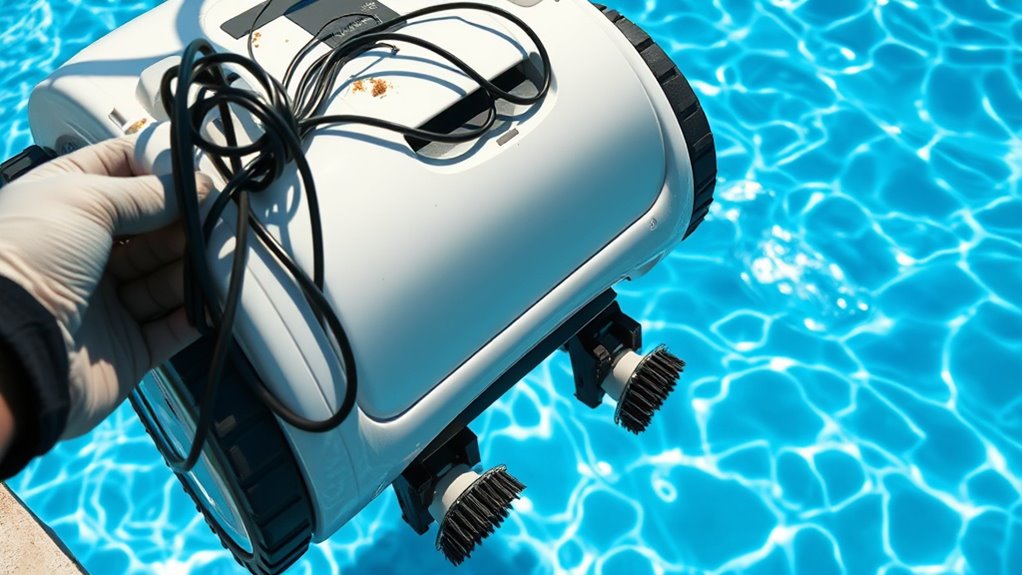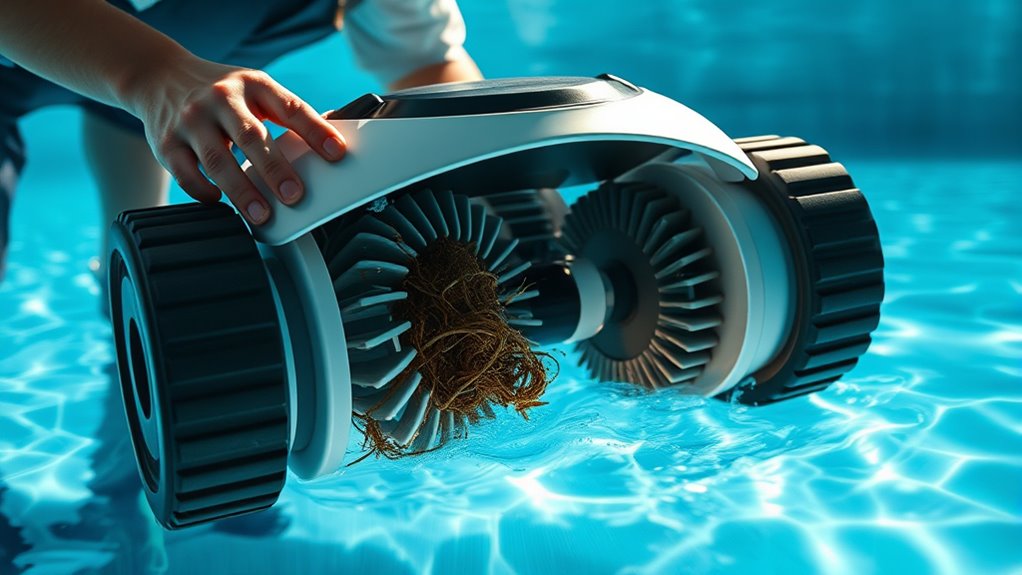To troubleshoot common robotic pool cleaner issues, start by inspecting and cleaning the filter, as debris can reduce suction and hinder movement. Check the power supply, including cords and outlets, to guarantee proper connection. Make sure the batteries are fully charged and replace them if the cleaner won’t hold a charge. Also, clean sensors and moving parts to prevent obstructions. If problems persist, some simple solutions might surprise you—continue exploring to learn more.
Key Takeaways
- Check and clean the filter regularly to prevent clogs that reduce suction and navigation.
- Verify the power connection and inspect cords or outlets for damage or disruption.
- Ensure the charging station and contacts are clean and unobstructed for proper battery charging.
- Inspect the battery condition; replace if it no longer holds a charge or the device runs intermittently.
- Clean sensors, wheels, and brushes to remove debris that may hinder movement or cleaning efficiency.

Robotic pool cleaners are convenient tools that keep your pool spotless, but like any device, they can encounter issues. One common problem relates to the cleaner’s ability to effectively vacuum and navigate the pool. Often, this stems from filter maintenance. Over time, debris, dirt, and algae can clog the filter, reducing suction power and impeding performance. Regularly check and clean the filter according to the manufacturer’s instructions. A clean filter guarantees excellent water flow and suction, enabling your robot to clean efficiently. If your cleaner seems sluggish or isn’t picking up debris as well, start by inspecting the filter and removing any buildup. Replacing the filter periodically also helps maintain peak performance, especially if it’s worn or damaged. Proper filter maintenance is essential for optimal operation, as it directly impacts the robot’s ability to perform its tasks effectively. Additionally, ensuring the proper cleaning intervals can prevent buildup and extend the lifespan of your cleaner’s components.
Regularly check and clean your robotic pool cleaner’s filter for optimal performance and efficient cleaning.
Power supply issues are another frequent culprit behind robotic pool cleaner problems. If your device isn’t turning on or moving as it should, check the power connection first. Ensure the power cord is securely plugged into a functioning outlet. Sometimes, the outlet itself might be the problem, so test it with another device to confirm it’s providing power. Inspect the cord for any visible damage or fraying, which can interrupt electrical flow. If your cleaner has a transformer, make sure it’s operating correctly. Sometimes, resetting the power supply or unplugging and plugging the device back in can resolve minor glitches. If the power supply continues to be an issue, replacing the transformer or power cord may be necessary. Additionally, ensure the robot’s charging station or dock is functioning properly. Dirty or obstructed contacts can prevent the robot from charging correctly. Clean the charging contacts with a soft cloth and check for any debris blocking the connection. Proper charging is essential for the robot’s operation, especially if it runs on batteries. If your device has a low battery or isn’t holding a charge, it might be time to replace the battery or seek professional help. To optimize performance, it’s also helpful to understand filter maintenance to keep the filter and other parts in top condition, as they also require proper maintenance and sometimes replacement. Regular inspections of the robot’s wheels, brushes, and sensors are also recommended to prevent obstructions that might hinder movement. Keeping an eye on these common issues and performing routine maintenance can prevent larger problems and extend the lifespan of your robotic pool cleaner. When problems persist despite troubleshooting, consulting the manufacturer’s instructions or contacting customer support often provides specific solutions tailored to your model. Additionally, understanding the role of electrical components can help you diagnose and resolve more complex power-related problems effectively.
Frequently Asked Questions
Can Robotic Pool Cleaners Work on Uneven Pool Surfaces?
You might wonder if robotic pool cleaners can handle uneven surfaces. The good news is, many models offer pool surface adaptation, allowing them to navigate uneven surfaces effectively. They use adjustable wheels and smart sensors to maintain contact and clean thoroughly. Just guarantee you choose a cleaner designed for your specific pool type, and it will work efficiently on uneven surfaces, giving you a cleaner pool without extra effort.
How Often Should I Replace the Brushes or Filters?
You should replace your robotic pool cleaner’s brushes and filters regularly to guarantee peak performance. Typically, inspect the brushes during brush maintenance every 2-3 months and replace them if they show signs of wear or damage. Filters need replacement every 1-2 months, depending on how often you use your cleaner and the debris levels in your pool. Regular maintenance keeps your cleaner running smoothly and extends its lifespan.
Are Robotic Pool Cleaners Safe for Solar Pool Covers?
You might wonder about solar cover safety and pool cover compatibility with robotic pool cleaners. Generally, these cleaners are safe for solar covers if they have gentle brushes and are designed to avoid damaging delicate surfaces. Check your cleaner’s specifications and confirm it’s compatible with your pool cover. Avoid aggressive scrubbing or heavy debris, and regularly inspect the cover for any signs of wear to maintain both safety and efficiency.
Why Does My Cleaner Make Unusual Noises During Operation?
Your pool cleaner’s noises are like a symphony gone wrong, signaling something’s amiss. Noisy motors often mean debris obstruction or loose parts causing vibrations. You might hear grinding or rattling, which indicates the brushes or wheels are struggling. Check for tangled hair, leaves, or other debris blocking the movement. Clearing these obstructions and tightening loose components usually quiets the noise, restoring your cleaner’s smooth, silent glide through your pool.
Can Robotic Pool Cleaners Be Used in Saltwater Pools?
You can definitely use robotic pool cleaners in saltwater pools, but check for saltwater compatibility first. Look for models with corrosion resistance, as saltwater can cause metal parts to wear faster. Many modern robotic cleaners are designed to withstand saltwater environments, ensuring durability and effective cleaning. Always verify the manufacturer’s specifications to prevent damage and extend the lifespan of your robotic pool cleaner in saltwater conditions.
Conclusion
Now that you’ve tackled those common robotic pool cleaner issues, you’re well-equipped to keep your device running smoothly. Think of it like a trusty steed in a medieval tale—regular care and quick troubleshooting ensure it stays loyal and efficient. With a little patience and some troubleshooting, your pool will sparkle like a gem, ready for your next swim. Remember, every knight needs their armor shining, so don’t hesitate to give your cleaner a little TLC.










